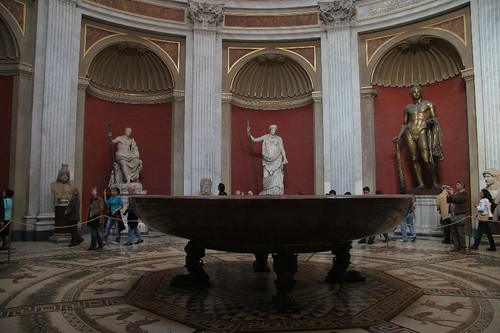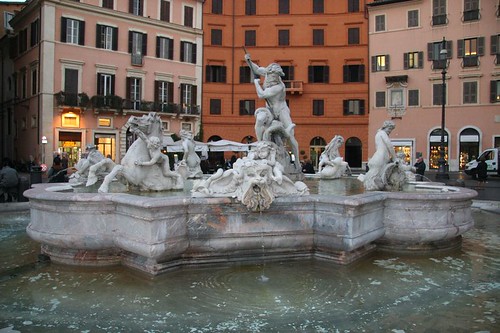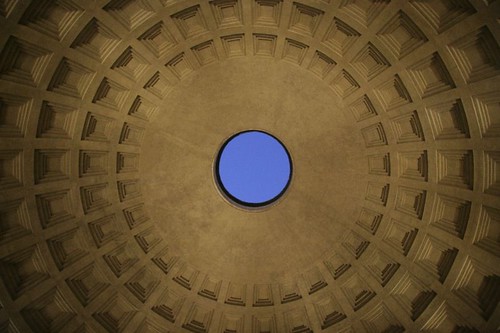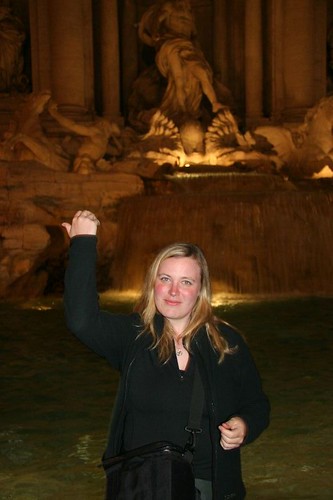Rome, November 14
Today was our last full day in Europe, our last day to see any of the sights. So we went to see the top sights in Rome: the Vatican, the Forum, the Coloseum and the Pantheon.
Our first visit was to the Vatican, since the museum there closed at 13h30. We didn’t really expect any troubles. We knew that it often experienced long lines, but at 9h30 on a Tuesday morning in November the number of visitors should be a small fraction of that in peak tourist seasons, right?
Perhaps, but when we arrived there was a massive line snaking out of sight; even worse, the line was not moving. The prospect of spending hours in line during our last day in Europe held little appeal as we looked on in dismay. We were quickly approached by a young lady with a British accent who informed us that she could get us in within 5 minutes for 25 Euros. She was selling tours of the museum. We very quickly decided to take her up on the offer and joined the group near the beginning of the line. Very quickly after the line joined the line started moving again, and moving quickly. I’m not sure what stopped the line, but it would have been a long wait none-the-less.
Even without the advantage of getting into the museum early, it was very nice to have a tour guide. You do get a much better feeling for things following around an experienced tour guide rather than wandering randomly and reading the placards.

I expected a large amount of Rennaisance artwork, and got it, but I did not expect so many Roman treasures. After all, these are pagan works, why are they being collected by a religious authority? Of course, that’s the reaction of a 20th century Lutheran upbringing, not that of luminaries in the Roman Catholic church of the 16th century. I expected decadence; other stops in our journey aptly illustrated this; the centre of the Roman Catholic empire would be the worst.
Travelling across Europe, looking at various Cathedrals, monuments and palaces, I was astounded by the amount of effort that would have been put into them. If built today using relatively accurate ancient techniques, these would cost tens of billions of dollars. To me, a modern equivalent would be the new war museum a few blocks away from my place. It’s one of our greatest national monuments to honour people and events important to us. It cost about $135 million dollars, a cost considered very large and contraversial. This is approximately equal to .01% of the GDP of Canada for a single year. If I remember correctly, Louis XIV spent about 50% of France’s GDP for several years building Versailles . The popes spent the GDP’s of many countries in Rome and Amiens, smaller regions spent large portions of their GDP building massive cathedrals, and the pyramids were estimated to consume 80% of the GDP of Egypt (again, figure pulled from my perhaps faulty memory), and the Roman emporers spent large amounts as well. These amounts are staggering.
For, by our standards, these massive empires were all impovershed third world countries. The vast majority of the economy was made of agriculture barely above the subsistence level. Life expectancies ranged between 25 and 40 years. Food consumed the large majority of the budget of most of the population. In Canada today, food consists of well under 10% of the spending of average Canadians.
The picture above is a good symbol of the decadence of the Roman emporer. It is one of Nero’s bathtubs that he installed in his pleasure palace. This was not his main home, but a vacation home. It was carved from a single piece of expensive marble, and could hold 23 people. That’s not so bad, you think, until you hear that Nero installed over 80 of these throughout the palace. That’s decadence.

(picture by Juan Ma from Wikipedia)
This is more a symbol of papal excess. If I remember correctly, the pope spent a year’s worth of his massive income in 1506 to acquire this Greek/Trojan masterpiece, considered by many to be the greatest statue ever carved. This is Laocoon, who was punished by Athena for throwing a spear at the Trojan horse, which was after all an offering by the Athenians to the goddess, besides its more well-known attributes. At least the pope established the Vatican museum around this piece to try and recover some of its purchase price. Of course, this massive amount pales into insignificance when compared to the price paid to build St. Peter’s.
After travelling through many rooms of Roman statuary (and greek statuary plundered by the Romans), we were treated to great collections of Rennaissance art. Of course, the pinnacle of this is the Sistine Chapel , the massive roof of which was painted by Michelangelo, who previously left us dumbfounded with his David in Florence.

(picture from http://artchive.com/ftp_site.htm via wikipedia)
Acknowledged by many to be one of the greatest works of art ever, do you realize that this was the first painting ever done by Michelangelo? He was a sculptor and architect, not a painter. And painting via plaster on a massive ceiling is a much more demanding work than oil on canvas! According to the story, it was a jealous Rapheal who convinced the pope to force Michelangelo to paint the ceiling, in an attempt to keep Michelangelo occupied for many years on a work that was guaranteed to fail. Of course, the joke was on Raphael.
And Michelangelo did play several jokes in the Sistine chapel. For example, they only recently discovered that a pair of small cherubs dancing around a figure considered symbolic of the pope were in a compromising position and giving the 16th century equivalent of the finger to him. In a later alterpiece in the chapel, Michelangelo paints a carekeeper burning in the pits of hell because he was the spy sent by the pope to report on the progress of painting, and who reported to the pope that the painting was scandalous for its large amount of nudity.
After the Sistine Chapel, the tour was over and we headed in to St. Peter’s Basicilica . We’ve previously reported on several other massive cathedrals elsewhere in Europe, but St. Peter’s puts them all to shame. Of course, as the central cathedral of the entire Roman Catholic empire, it’s supposed to. I’m not going to say very much about it, I won’t do it justice. Other’s probably do .
After St. Peter’s, it was lunch time, so we grabbed a piece of lukewarm pizza from a roadside vendor and set out on an important quest. We needed to find a 15mm wrench. Last night we had spent over an hour trying to get the pedals off of Bethany’s bike. We had tightened them down with a small hand wrench in Copenhagen, but they then started squeaking, so a bike mechanic tightened them down hard with a very long wrench. We tried to improvise levers, but we could not get them off, so we needed to buy a wrench of similar size as the one used to tighten them down. We located a bicycle store, but they were closed for siesta. We decided to go off and see the Forum and the Coloseum and then come back.

The Forum was the centre of Rome. This is where everything happened. Unfortunately, it had been covered by many metres of mud over the centuries, so it has been mainly destroyed and plundered. Hints of past grandeur can be seen, but mostly imagination is required. Two things stood out for me: the Curia and Julias Caesar’s ashes.
The Curia was impressive for it’s unimpressiveness. This was where the Senate met. A brick building about the size of a basketball court, I would have expected the centre of Republican Rome to be much grander and impressive. I suppose they had other priorities in the time before Caesar. it was converted into a church in the 7th century, so may have lost something then, but that also meant that efforts would have been made to preserve it.
Julius Caesar’s ashes had flowers placed on them, and still appeared to be a place of pilgrimage. Interesting, given that it’s been a while since he was worshipped as a god.

Right beside the Forum was the Coloseum. Impressive in it’s size and history, it is not nearly in as good a shape as the one in Nimes. In many ways, this was a let down, since we’d already been blown away by the arena in Nimes. Still one of the highlights of Rome, though.

We then walked back to the bicycle store and purchased a wrench, which did work well on Bethany’s pedals. We then headed to the Pantheon, passing through the Piazza Navona. The Piazza Navona features two fountains and sculptures by Bernini. I find that I am really coming to appreciate statuary. We have viewed some of the best statues in the world, such as the Venus de Milo, David and Laocoon. Bernini is also a master.

We arrived at the Pantheon as dusk was falling. This very famous dome was designed by Emperor Hadrian. It’s donation by the Roman Emperor to the pope in 608 ensured that it would be preserved over the centuries as a church. Recently restored, I wish it would have been restored as a Roman temple, but alas, it is still a functioning church and contains its trappings.
We saw homages to this famous dome throughout our tour of the Vatican. If you check out Bethany’s pictures, you will see pictures of domes that look very similar. St. Peter’s dome was designed by Michelangelo as slightly smaller. When you visit, you will understand why. It has been described as perfection, and that doesn’t seem to be inaccurate. A perfect hemisphere with a diameter of 43.3m, the simple design with the occulus in the middle is very pleasing to the eye.
After visiting the Pantheon, we headed out for supper. Given that this was probably going to be our last chance to have a real meal in Europe, we wanted it to be special. We ended up choosing something rather inexpensive, the restaurant that our guide book described as the “best pizza in Rome”. While I agree that it was very good pizza, I have many times experienced pizza that I consider much better. The crust was the thinnest that I have ever seen anywhere. It was approximately the thickness of a tortilla. The sauce and toppings were good, but if that’s the best pizza in Rome, I’d be surprised. The best part was an egg on one of the pizzas. It was like somebody perfectly fried an egg in the middle of the pizza.

Our next stop was Trevi fountain to throw coins over our shoulders, as immortalized by the movie, Three Coins in the Fountain. It was on a list of “top ten romantic spots” in our guidebook, so we decided to also hit number 10, a tartufo at Tre Scalini, which was rather fabulous. The romantic thing to do is to share one, but they looked so good they we each got one!
We had been handed a flyer advertising a chamber orchestra playing Vivaldi’s Four Seasons and a few other pieces, so we decided to take that in to complete our time in Rome. Unfortunately, we had a large amount of trouble finding the church the orchestra was playing in, since the map on the flyer was wrong. We did find it, though, and arrived only a few minutes into the concert. It was interesting visiting an Anglican church after visiting so many Catholic churches in Belgium, France and Italy!
Tomorrow we journey home. We stopped at the train station to double check things. It appears that it won’t be as straightforward as our test journey on Monday indicated; I’m going to wake up in about 4 hours or so to ensure we get the right tickets. Cross your fingers…
Comments
David on 21 Nov 19:24
Marie-Elizabeth on 22 Nov 16:12